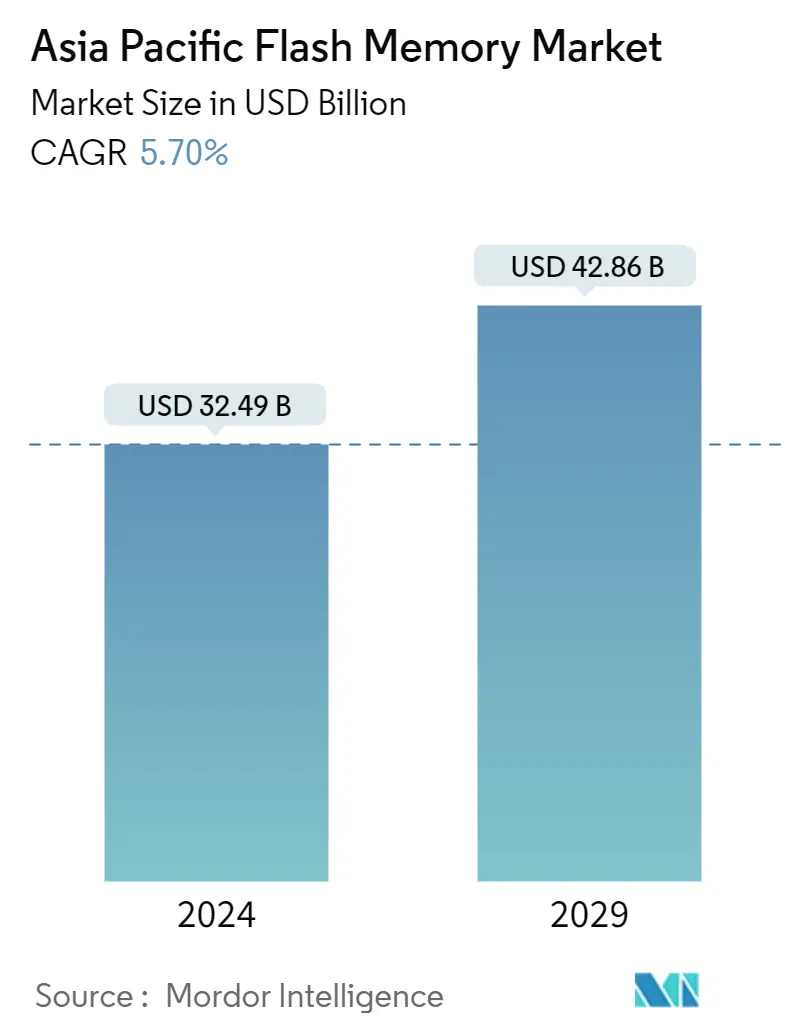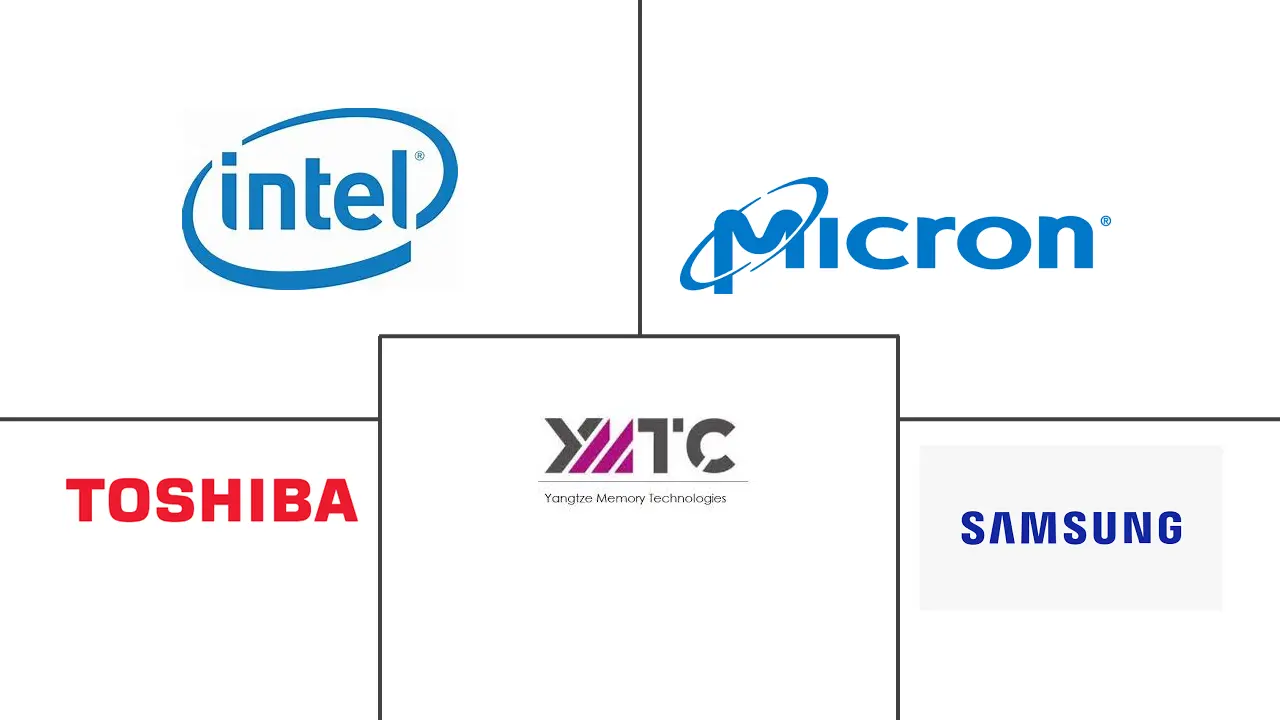Market Size of Asia Pacific Flash Memory Industry

| Study Period | 2019 - 2029 |
| Base Year For Estimation | 2023 |
| Market Size (2024) | USD 32.49 Billion |
| Market Size (2029) | USD 42.86 Billion |
| CAGR (2024 - 2029) | 5.70 % |
| Market Concentration | Medium |
Major Players
*Disclaimer: Major Players sorted in no particular order |
Asia Pacific Flash Memory Market Analysis
The Asia Pacific Flash Memory Market size is estimated at USD 32.49 billion in 2024, and is expected to reach USD 42.86 billion by 2029, growing at a CAGR of 5.70% during the forecast period (2024-2029).
The growth of the market is favored by various factors, such as growing sales of consumer electronic products, including smartphones, laptops, tablets, and smartwatches, increasing penetration of IoT technology, and the emergence of data-centric applications in numerous industry verticals. China, South Korea, Japan, and India, among others, are major Asian Pacific countries. Asia Pacific is a massive marketplace for non-volatile memory technologies as the area dominates many manufacturing subsectors of other end-user industries and the global semiconductor manufacturing sector. In the market under study, nations like China offer low-cost products.
- Notably, memory manufacturers reported no major impact on flash memory supply in the APAC region, but weakening demand impacted flash memory prices as the electronics device sector was impacted significantly by the COVID-19 outbreak, as China is one of the major suppliers of raw materials and finished products. Moreover, the Indian smartphone manufacturing sector was heavily impacted owing to COVID-19. During the pandemic, smartphone manufacturers such as Samsung, Vivo, Oppo, Motorola, Xiaomi, and LG said they closed their factories for various periods. Apple had also shut down its four sales offices in India and the development center for maps in Hyderabad to prevent coronavirus spread among its employees.
- Furthermore, weakened sales of retail storage products such as memory cards and USB drives were observed, but the demand remained fairly strong in the main application segments owing to the arrival of the traditional peak season and the growth in the procurement related to data centers. The widespread work- and the learn-from-home transition has facilitated a near-term boost to the memory suppliers, leading to first-half memory bit shipments higher than previously anticipated. market
- The flash memory market is growing at a significant rate. New systems and products that are smarter, integrated, all-encompassing, and more economical are contributing to this. Additionally, the gradual acceptance of industry-wide specifications contributed to flash market growth. As a result, the flash industry has grown with the adoption of various interface specifications, especially those relating to the consumer device industry.
- Expanding digital transformation in the region proliferates the demand for data center capacity beyond traditional Tier 1 data centers. Demand in emerging markets such as mainland China, India, and Indonesia continues to gain momentum along with other large emerging markets in Southeast Asia, such as Vietnam and Thailand, coming into view as high-potential markets with burgeoning local needs. Thus, companies in APAC are investing in data center infrastructure management owing to the technology boom and big data, and these new trends are beginning to emerge in the commercial real estate sector, presenting high data storage demand,
- Moreover, the rising disposable income and the growing manufacturing and sales of luxurious automobiles with various features such as ADAS, infotainment, drive video/data recorder, or instrument cluster are further driving the role of flash memory as reported by Toshiba that the average autonomous vehicle is likely to generate data at the rate of 4 terabytes per day, and a significant amount that data will be uploaded to the cloud. The majority of it is likely to sit in flash memory chips residing both on vehicles and in data centers, and the upshot of these trends is a boom time for flash memory chips that can handle the special needs of vehicles.
Asia Pacific Flash Memory Industry Segmentation
Flash memory is a type of non-volatile memory that electronically erases data in blocks and rewrites the data at the byte level. There are two types of flash memory - NOR flash and NAND flash. Flash memory is widely used for storage and data transfer in consumer devices, enterprise systems, and industrial applications. The market study comprises the value and volume of flash memory.
The Asia Pacific Flash Memory Market is segmented by Type (NOR flash memory (by density (2 MEGABIT & LESS, 4 MEGABIT & LESS (greater than 2MB), 8 MEGABIT & LESS (greater than 4MB), 16 MEGABIT & LESS (greater than 8MB), 32 MEGABIT & LESS (greater than 16MB), 64 MEGABIT & LESS (greater than 32MB))), NAND flash memory (by density (128 MB & LESS, 512 MB & LESS, 2 GIGABIT & LESS (greater than 1GB), 256 MB & LESS, 1 GIGABIT & LESS, 4 GIGABIT & LESS (greater than 2GB))), by end user (data center (enterprise and servers), automotive, mobile and tablet, client (PC, client SSD)), other End-user applications). The report offers the market size in value terms in USD for all the above mentioned segments.
| By Type | |||||||||||
| |||||||||||
|
| By End User | |
| Data Center (Enterprise and Servers) | |
| Automotive | |
| Mobile & Tablets | |
| Client (PC, Client SSD) | |
| Other End-user Applications |
Asia Pacific Flash Memory Market Size Summary
The Asia Pacific Flash Memory Market is poised for significant growth, driven by the increasing demand for consumer electronics such as smartphones, laptops, and tablets, alongside the rising penetration of IoT technologies. The region's dominance in manufacturing and semiconductor production, particularly in countries like China, South Korea, Japan, and India, positions it as a crucial player in the global flash memory landscape. The market's expansion is further supported by the burgeoning data-centric applications across various industries, including automotive and smart city developments. Despite challenges posed by the COVID-19 pandemic, which affected supply chains and demand in certain segments, the market has shown resilience with a strong recovery in key application areas like data centers and automotive technologies.
The flash memory industry in Asia Pacific is characterized by a semi-consolidated market structure, with major players such as Samsung, Toshiba, and SK Hynix leading the charge. These companies are heavily investing in research and development to innovate and meet the evolving demands of big data and advanced technologies. The automotive sector, in particular, is witnessing a surge in demand for flash memory due to the increasing adoption of advanced driver-assistance systems (ADAS) and the rise of electric and hybrid vehicles. Additionally, the region's focus on digital transformation and smart city initiatives is driving the need for robust data storage solutions. As the market continues to evolve, strategic collaborations and technological advancements, such as those seen with Western Digital and Kioxia, are expected to shape the future landscape of flash memory in the Asia Pacific region.
Asia Pacific Flash Memory Market Size - Table of Contents
-
1. MARKET INSIGHTS
-
1.1 Market Overview
-
1.2 Supply Chain Analysis
-
1.3 Impact of macro trends (post-COVID-19 scenario, supply chain disruptions, and economic uncertainties among others) on the Market
-
1.4 Industry Attractiveness - Porter's Five Forces Analysis
-
1.4.1 Threat of New Entrants
-
1.4.2 Bargaining Power of Buyers/Consumers
-
1.4.3 Bargaining Power of Suppliers
-
1.4.4 Threat of Substitute Products
-
1.4.5 Intensity of Competitive Rivalry
-
-
-
2. MARKET SEGMENTATION
-
2.1 By Type
-
2.1.1 NAND Flash Memory
-
2.1.1.1 By Density
-
2.1.1.1.1 128 MB & LESS
-
2.1.1.1.2 512 MB & LESS
-
2.1.1.1.3 2 GIGABIT & LESS (greater than 1GB)
-
2.1.1.1.4 256 MB & LESS
-
2.1.1.1.5 1 GIGABIT & LESS
-
2.1.1.1.6 4 GIGABIT & LESS (greater than 2GB)
-
-
-
2.1.2 NOR Flash Memory
-
2.1.2.1 By Density
-
2.1.2.1.1 2 MEGABIT & LESS
-
2.1.2.1.2 4 MEGABIT & LESS (greater than 2MB)
-
2.1.2.1.3 8 MEGABIT & LESS (greater than 4MB)
-
2.1.2.1.4 16 MEGABIT & LESS (greater than 8MB)
-
2.1.2.1.5 32 MEGABIT & LESS (greater than 16MB)
-
2.1.2.1.6 64 MEGABIT & LESS (greater than 32MB)
-
2.1.2.1.7 Others
-
-
-
-
2.2 By End User
-
2.2.1 Data Center (Enterprise and Servers)
-
2.2.2 Automotive
-
2.2.3 Mobile & Tablets
-
2.2.4 Client (PC, Client SSD)
-
2.2.5 Other End-user Applications
-
-
Asia Pacific Flash Memory Market Size FAQs
How big is the Asia Pacific Flash Memory Market?
The Asia Pacific Flash Memory Market size is expected to reach USD 32.49 billion in 2024 and grow at a CAGR of 5.70% to reach USD 42.86 billion by 2029.
What is the current Asia Pacific Flash Memory Market size?
In 2024, the Asia Pacific Flash Memory Market size is expected to reach USD 32.49 billion.

